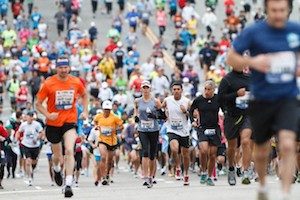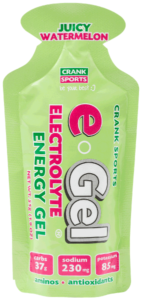Marathon Race Day Tips and Nutrition Strategies
Marathon Race Day Tips and Nutrition Strategies
 Once you have put in your mileage and properly trained with e-Gel, you will be ready to turn in that PR on race day (or be a first time finisher). If you intend to use just e-Gel and water then this article is for you. If you want to use e-Fuel or another sports drink with your energy gel then you should also read when to use gels and drinks.
Once you have put in your mileage and properly trained with e-Gel, you will be ready to turn in that PR on race day (or be a first time finisher). If you intend to use just e-Gel and water then this article is for you. If you want to use e-Fuel or another sports drink with your energy gel then you should also read when to use gels and drinks.
pre-race prep
race nutrition
 If you choose, you can do your first e-Gel 5-10 minutes before the race, but don’t forget to flush it down with a few ounces of water. During the race we recommend consuming one e-Gel pack every five miles (see table below). Always follow e-Gel with at least a few ounces of water. If you don’t carry your own water then find out ahead of time where the water stops are. Then you can plan where and when you will take each dose of e-Gel. It is important to go into the race with a well thought out race strategy – including your race pace, hydration and nutrition plans.
If you choose, you can do your first e-Gel 5-10 minutes before the race, but don’t forget to flush it down with a few ounces of water. During the race we recommend consuming one e-Gel pack every five miles (see table below). Always follow e-Gel with at least a few ounces of water. If you don’t carry your own water then find out ahead of time where the water stops are. Then you can plan where and when you will take each dose of e-Gel. It is important to go into the race with a well thought out race strategy – including your race pace, hydration and nutrition plans.
Remember that water intake is critical to proper gel assimilation and we recommend consuming 14 ounces of water for each gel pack consumed. This does NOT mean that you should drink 14 ounces all at once, but you should drink 14 ounces before you rip open your second gel pack (an so on). The logic behind this is that if you are properly hydrated then you will have 20-30 ounces of available water in your stomach and intestinal tract. This water can be used to assimilate the gel, but if you don’t replace it then you can become dehydrated. If you’re not good about drinking water during a race then we recommend that you cut back your gel intake accordingly – or better yet, learn to drink water during the race! Dehydration is a sure way to have a bad race, or worse yet, suffer potentially serious health consequences.
| Marathon Pace min/mi | Distance One e-Gel Every: | Time One e-Gel Every: |
| 5 min | 5 miles | 25 min |
| 6 min | 5 miles | 30 min |
| 7 min | 5 miles | 35 min |
| 8 min | 5 miles | 40 min |
| 9 min | 5 miles | 45 min |
| 10 min | 5 miles | 50 min |
| 11 min | 5 miles | 55 min |
| 12 min | 5 miles | 60 min |
| 13 min | 5 miles | 65 min |
| 14 min | 5 miles | 70 min |
| 15 min | 5 miles | 75 min |
can you use more?
the golden rule
if you found this useful please share!
related resources
gels, drinks, chews ... what's best for your sport?
Use our Sherpa Nutrition Guide tool to get your nutrition dialed in. Just plug in your sport, problems you’re having (cramping, stomach issues, running out of energy) and Sherpa will give you a detailed person guide. Free, quick and easy!
what is an energy gel and who should use them
Many people are not fans of energy gels at first because they can be sticky, thick and hard to get down. Why would anyone use an energy gel? Why not just stick to energy bars and sports drinks? All good questions… read on
when to use energy gels and sports drinks and can they be used together
If you decide to use e-Gel and e-Fuel together (or any energy gel and sports drink), follow these guidelines for best results.
hydration and proper use of energy gels
Before building an energy gel into your training and competition program, it is critical to understand the importance of proper hydration.
energy gels are a better choice than bars and chews
Protein bars, energy gels, chews, hydration drinks, fruit … what should you use? Making the right selection can significantly improve performance.
marathon training with e-Gel
ingredient articles
fat and protein during your race, don't do it!
In order to achieve optimum performance in any endurance sport you need to maximize oxygen delivery to the working muscles. What you eat plays a significant role.
fructose, you need some!
Fructose often gets a bad rap, but using it properly will actually give you an advantage, learn how.
hyponautremia, electrolytes may save your life
race tips and strategy
the marathon wall and how to avoid it
The bad news is that “the wall” is a very real thing. The good news is that you can avoid “hitting the wall” if you follow this advice.

